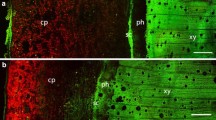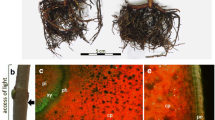Abstract
In woody species, the photosynthesis of stems, especially young branches, occurs by refixing part of the internal respiratory CO2. The present study aims to improve the physiological characterization of stem photosynthesis by examining enzymatic characteristics. During an entire growing season, three enzymatic activities that are linked to C3 and C4 metabolism were investigated in relation to the CO2 efflux and chlorophyll content of current year stems of European beech and were compared to the corresponding characteristics of leaves. High activities of phosphoenolpyruvate carboxylase (PEPC) and NADP malic enzyme were detected in stems (up to 13 times and 30 times higher in stems than in leaves, respectively), whereas Rubisco activity remained low in comparison with leaves. Stem maximal Rubisco and PEPC activities occurred at the beginning of the season when the total chlorophyll content and the CO2 assimilation rate were also maximal. Stems were characterized by a PEPC:Rubisco ratio that was equal to 2.5 [an intermediate value between that of C3-plants (about 0.1) and that of C4-plants (about 10)], whereas it was equal to 0.1 in leaves. Eight other tree species were also measured and the PEPC:Rubisco ratio was, on average, equal to 3.6. The potential role of PEPC in stem carbon assimilation is discussed in relation to its known involvement in the anaplerotic function of C3 plants and in the carbon metabolism of the C4 pathway.






Similar content being viewed by others
Abbreviations
- Rd:
-
CO2 efflux in the dark (or dark respiration rate)
- Rl:
-
Mean CO2 efflux in the light
- Pg:
-
Apparent gross photosynthesis rate
- Rubisco:
-
Ribulose-1,5-bisphosphate carboxylase/oxygenase
- PEPC:
-
Phosphoenolpyruvate carboxylase
- NADP ME:
-
NADP malic enzyme
References
Alessio GA, Pietrini F, Brilli F, Loreto F (2005) Characteristics of CO2 exchange between peach stems and the atmosphere. Funct Plant Biol 32:787–795
Alves G, Ameglio T, Guilliot A, Fleurat-Lessard P, Lacointe A, Sakr S, Petel G, Julien J-L (2004) Winter variation in xylem sap pH of walnut trees: involvement of plasma membrane H+-ATPase of vessel-associated cells. Tree Physiol 24:99–105
Atkin OK, Evans JR, Ball MC, Lambers H, Pons TL (2000) Leaf respiration of snow gum in the light and dark. Interactions between temperature and irradiance. Plant Physiol 122:915–924
Berveiller D, Kierzkowski D, Damesin C (2007) Interspecific variability of stem photosynthesis among tree species. Tree Physiol 27:53–61
Bradford MM (1976) A rapid and sensitive method for the quantification of microgram quantities of protein utilizing the principle of protein-dye binding. Anal Biochem 72:248–254
Damesin C (2003) Respiration and photosynthesis characteristics of current-year stems of Fagus sylvatica: from the seasonal pattern to an annual balance. New Phytol 158:465–475
Famiani F, Walker RP, Tecsi L, Chen Z-H, Proietti P, Leegood RC (2000) An immunohistochemical study of the compartmentation of metabolism during the development of grape (Vitis vinifera L.) berries. J Exp Bot 51:675–683
Hausler RE, Rademacher T, Li J, Lipka V, Fischer KL, Schubert S, Kreuzaler F, Hirsch H-J (2001) Single and double overexpression of C4-cycle genes had differential effects on the pattern of endogenous enzymes, attenuation of photorespiration and on contents of UV protectants in transgenic potato and tobacco plants. J Exp Bot 52:1785–1803
Hibberd JM, Quick WP (2002) Characteristics of C4 photosynthesis in stems and petioles of C3 flowering plants. Nature 415:451–454
Höll W (1974) Dark CO2 fixation by cell-free preparations of the wood of Robinia pseudoacacia. Can J Bot 52:727–734
Langenfeld-Heyser R (1989) CO2 fixation in stem slices of Picea abies (L.) Karst: microautoradiographic studies. Trees Struct Funct 3:24–32
Lasa B, Frechilla S, Aparicio-Tejo PM, Lamsfus C (2002) Role of glutamate dehydrogenase and phosphoenolpyruvate carboxylase activity in ammonium nutrition tolerance in roots. Plant Physiol Biochem 40:969–976
McGuire MA, Teskey RO (2002) Microelectrode technique for in situ measurement of carbon dioxide concentrations in xylem sap of trees. Tree Physiol 22:807–811
Nilsen ET (1995) Stem photosynthesis: extent, patterns, and role in plant carbon economy. In: Gartner B (ed) Stems and trunks in plant form and function. Academic Press, San Diego, pp 223–240
Pfanz H, Aschan G (2001) The existence of bark and stem photosynthesis in woody plants and its significance for the overall carbon gain. An eco-physiological and ecological approach. In: Prog. Bot. Springer, Berlin, pp 478–510
Pfanz H, Aschan G, Langenfeld-Heyser R, Wittmann C, Loose M (2002) Ecology and ecophysiology of tree stems: corticular and wood photosynthesis. Naturwissenschaften 89:147–162
Porra RJ, Thompson WA, Kriedemann PE (1986) Determination of accurate extinction coefficients and simultaneous equations for assaying chlorophylls a and b extracted with four different solvents: verification of the concentration of chlorophyll standards by atomic absorption spectroscopy. Biochim Biophys Acta 975:384–394
Rosendahl L, Vance CP, Pedersen WB (1990) Products of dark CO2 fixation in pea root nodules support bacteroid metabolism. Plant Physiol 93:12–19
Schaedle M, Brayman A (1986) Ribulose-1,5-bisphosphate carboxylase activity of Populus tremuloides Michx. bark tissues. Tree Physiol 1:53–56
Scholander PF, Hammel HT, Bradstreet ED, Hemmingsen EA (1965) Sap pressure in vascular plants. Science 148:339–346
Sun Q, Yoda K, Suzuki M, Suzuki H (2003) Vascular tissue in the stem and roots of woody plants can conduct light. J Exp Bot 54:1627–1635
Tietz S, Wild A (1991) Investigations on the phosphoenolpyruvate carboxylase activity of spruce needles relative to the occurrence of novel forest decline. J Plant Physiol 137:327–331
Uedan K, Sugiyama T (1976) Purification and characterization of phosphoenolpyruvate carboxylase from maize leaves. Plant Physiol 57:906–910
Van Cleve B, Forreiter C; Sauer JJ, Apel K (1993) Pith cells of poplar contains photosynthetically active chloroplasts. Planta 189:70–73
Von Caemmerer S, Farquhar GD (1981) Some relationships between the biochemistry of photosynthesis and the gas exchange of leaves. Planta 153:376–387
Wittmann C, Pfanz H, Loreto F, Centritto M, Pietrini F, Alessio G (2006) Stem CO2 release under illumination: corticular photosynthesis, photorespiration or inhibition of mitochondrial respiration? Plant Cell Environ 29:1149–1158
Acknowledgments
This research was financed by the French projects “Ministère délégué à la recherche—ACI Jeunes Chercheurs” no. JC10009 and “Programme National ACI/FNS ECCO, PNBC” (convention no. 0429 FNS). The ESE laboratory is supported by the University Paris XI and CNRS.
Author information
Authors and Affiliations
Corresponding author
Additional information
Communicated by H. Pfanz.
Rights and permissions
About this article
Cite this article
Berveiller, D., Damesin, C. Carbon assimilation by tree stems: potential involvement of phosphoenolpyruvate carboxylase. Trees 22, 149–157 (2008). https://doi.org/10.1007/s00468-007-0193-4
Received:
Revised:
Accepted:
Published:
Issue Date:
DOI: https://doi.org/10.1007/s00468-007-0193-4




